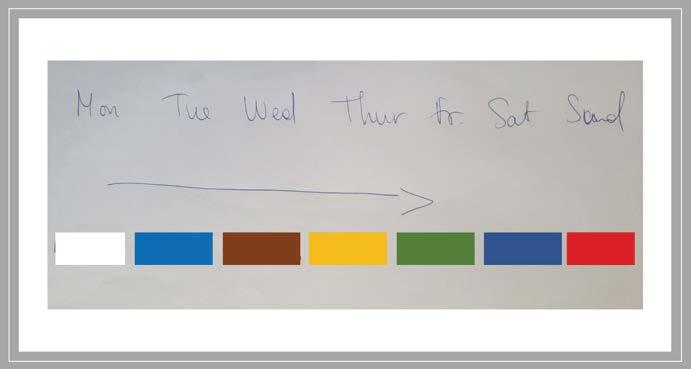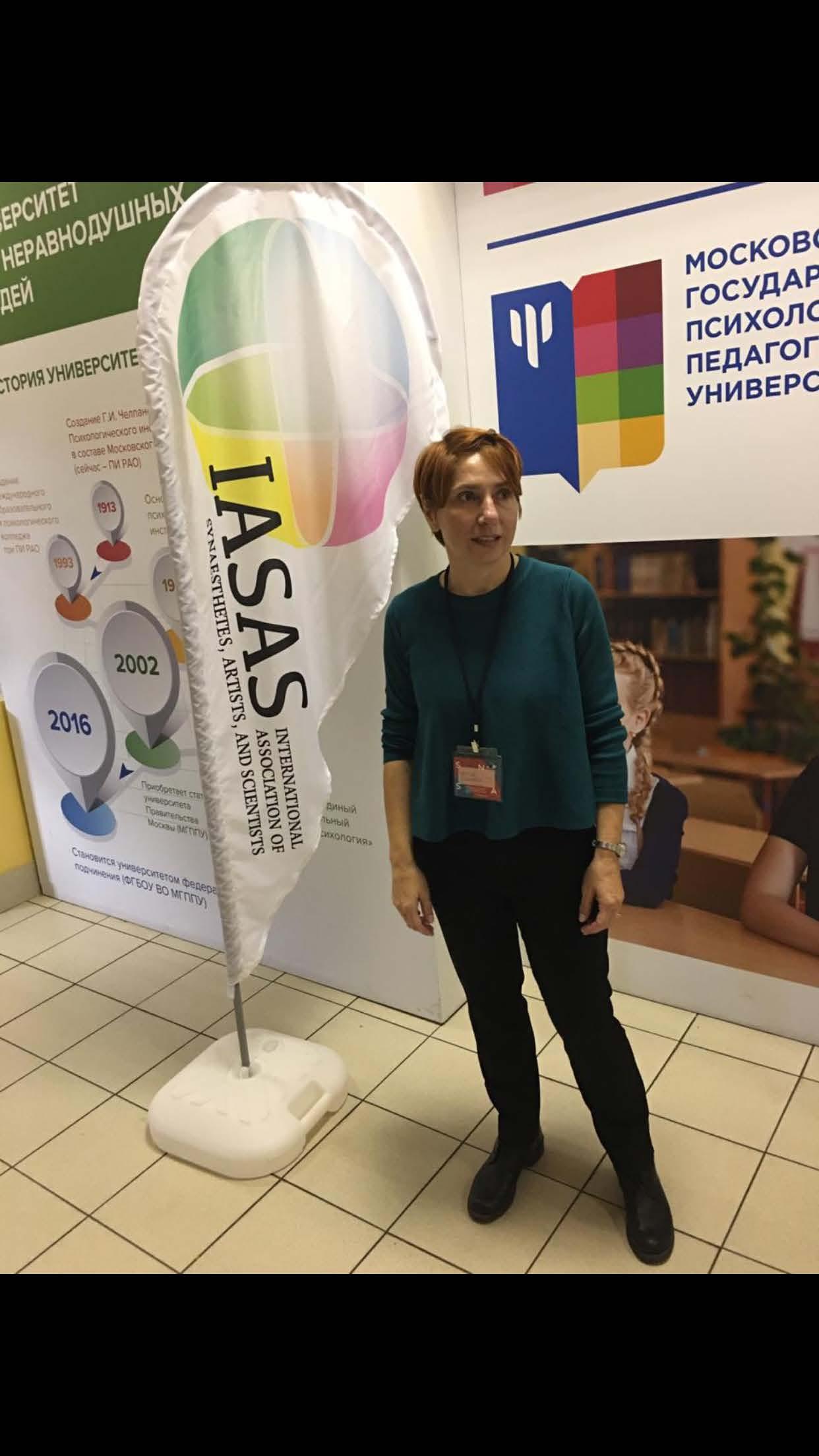
14 minute read
American Community Schools of Athens
Synaesthesia: A New Welcoming Adventure In The American Community Schools Of Athens

by Effie Zografou - Elgabry Fellow, The Institute of ACS Athens
Blending of powers! The sweet smell of Red! Imagine a child in class who doesn’t like to talk because of the bad taste of his voice or another child who loves a certain teacher because her voice is violet and smells good. Imagine that the wind tastes like sugar cane. Imagine that you could smell distances. Imagine the voices of people that surround you to feel like coloured fireworks, or imagine that time has shapes and that words have personalities. Well, you can let your imagination fly, because guess what? This magical world is not imaginary; it is a very real phenomenon called Synaesthesia that allows you to taste words, see and smell sounds, and hear colours. Monday might be an angry or depressed young man wearing a white shirt; the number three might be blue and moody; February can be brown, and the letter “S” can be golden yellow. Welcome to the world of Synaesthesia! I hope to enlighten readers young and old about this rare beauty of a phenomenon, as well as share the incredible initiative ACS Athens is on to support young learners who are gifted with Synaesthesia!
What is Synaesthesia Synaesthesia is a perceptual phenomenon in which stimulation of one sensory or cognitive pathway leads to automatic, involuntary experiences in a second sensory or cognitive pathway. The term Synaesthesia is derived from the Greek syn =union and aesthesia = sensation, and refers to the capacity of conjoining two sensory experiences while one sense is stimulated, e.g. hearing colours, or feeling sounds etc. It is a neurological condition whereby stimulation of one sense automatically evokes a perception in an unstimulated sense. For example, the sound of a ringing bell may trigger seeing the colour pink or seeing an oval shape. You might see colours when reading numbers and letters or experience tastes in the mouth when hearing sounds. A beautiful blending of powers!
There are multiple types of Synaesthesia. For instance, Grapheme-Colour Synaesthesia blends the words with colours while Sound-Colour Synaesthesia blends the sounds with colours. Mirror-Touch, on the other hand, is the tendency for an individual to react in a mirror-like movement of another person. Chromesthesia or Sound-to-colour-Synaesthesia is when sound involuntary evokes an experience of colour, and Spatial Sequence Synaesthesia is when ordinal sequences, such as months, numbers or the letters of the alphabet are experienced as specific forms and volumes in space. Other types include Grapheme-Personification, Touch-Temperatures, Smell-Emotion, Smell-Taste, Sound-Touch, Vision- Touch, and a whole lot more that brings a total of 80 registered types of Synaesthesia!
Famous Synesthetes include novelist Vladimir Nabokov (Grapheme-Colour), who saw each letter in a different hue; musician Duke Ellington, who interpreted notes as colours; painter Joan Mitchell, who associated colours with letters, sounds and personalities; or scientists Nikola Tesla and Richard Feynman, as well as Academy Award winning actor Geoffrey Rush (Grapheme-Colour and Spatial Sequence Synaesthesia SSS), and iconic pianist-composer Franz Liszt (Chromesthesia), and last but not least, Vincent van Gogh (Chromesthesia) among others, are also thought to have had Synaesthesia.
The Greek philosopher and mathematician Pythagoras, who himself displayed signs of the remarkable trait, produced the first known description of Synaesthesia around 500 B.C., but the first known reference to Synaesthesia in scientific writing dates to 1690, from John Locke’s account of a blind man who described the colour scarlet as “the sound of a trumpet”. Similar isolated case-studies continued for some time, and it was described in detail by Francis Galton at UCL in 1883. It is only recently, however, that we have grown accustomed to Synaesthesia, now included in the syllabus of psychology as we continue to learn about this incredible phenomenon. Only 4% of the total population is reportedly synesthetic; well,
I am one of them...and it is fascinating!
My Synaesthesia: A Late Bloomer I am an Associator Grapheme-Colour Synesthete, which means that all letters, words, numbers, days of the week, months and years have colours! For instance, my A is red, my 11 is black, my Monday is white, and my November is blue. I also have Spatial Sequence Synaesthesia, where I see days of the week in a horizontal line of coloured blocks.

When it comes to numbers, no matter the magnitude, my numbers grow vertically in a line, upwards. They all go up in what looks like a simple dark row and have no shapes at all (but in numerical form). Some might say I have a Personification-based Synaesthesia as well, since they are so dark and utterly moody.
On the other hand, calendar months are funny and cute; I would describe them as train stations, because they form an oval shape and each month has a permanent position on that oval, like a station. They are static and only I can move, like a train. I can zoom in towards them or zoom out away from them, but they never change position. When I drew them for the first time, I realised that the months belonging to the seasons of winter and spring are more tightly condensed into each other, with a darker background, as opposed to the wider, lighter warmer months. I am always aware of the current month, because like a magnetic force, I cannot escape my current position, but I can visit previous months. I can only do this by zooming out to the previous month, but only for a short time, as I will be dragged back to the current month, like an elastic band. This happens every time I would like to visit my memories.
All my months take a clear colour from the first and dominant letter of the word. August, for example, is red, because A is red. September is a golden yellow, because S is a golden yellow and so on. There is, however, an exception to this rule for two months. April and October.
April is green, though A is red. And October is cherry red, though O is white. The only explanation I can think of to explain this, is that the sound of the first syllable of the word October is the sound οκτώ, okto (8) which in Greek means the number eight. The number eight has a cherry red colour for me, so October might be getting a little confused, taking its colour from the number instead of the dominant letter. The same might be happening for April. April should be red because of its first dominant letter A, which is red. But April is green because it is taking its colour from second letter π from Απρίλιος, Aprilios in Greek, which is green. It is important to note that, when describing the colours I see, it is not easy to describe the precise colours of my mind-eye; could there be a way to generate these? Possibly a future project!
Now, for the days of the week, there seems to be no rule at all. The colour I see does not match with the first dominant letter of the word. Monday is white, although it should be sunny yellow, like the letter M. Tuesday is blue, although it should be almost completely black like the letter T. Wednesday is pure sweet brown, though it should be a kind of grey-brownish. Thursday is yellow, although T, as I mentioned, is almost black. Friday is green, although F is a grey. Saturday is blue, while Sunday is red, despite S being a golden yellow. This is a nice mystery which I have yet to explain, and I know that I am probably annoying any synesthetes reading my article right now, as their colours might be completely different!
How I realised I had Synaesthesia For many years, I had not realized that I was, and am, a Synesthete. I thought that everybody, like me, experienced the same colours in their everyday life. I found out very late, after my 30’s, that this is not a common part of people’s lives.
Yet, even when I discovered my Synaesthesia, it was by accident. I was playing a made-up game with my kids one day, when my daughter required us to remember certain numbers with a special colour for each. Without going into much detail, I accidentally mentioned that this was too easy since each number already had its own colour, but they could not understand what I meant. It was from this point onwards that I unintentionally entered the very real game of Synaesthesia, which has now become a core aspect of my life. Synaesthesia also helps me understand why I sense other people’s emotions, with a kind of a lighter or heavier internal blushing feeling. From that moment on, I began to distinguish my colourful synesthetic aspects of my life, which are not common to everybody.
I started to enjoy discovering more and more, day after day, these colours, that have helped me to remember things easier. As an associator (as opposed to a projector Synesthete), I balance between reality written colours and what is referred to as my mindeye colours (i.e. what my head tells me I see). I can see them the way they are given, but I translate them into my own colours. Can you imagine the struggle of a student in class trying to copy things down from the black board or trying to write something down on a computer, where all the letters or numbers are either black or white? This, for me, is unbelievably wrong! Nonetheless, as an associator, I can distinguish and switch between both worlds: the reality written colours and my mind-eye colours.
– until I was into my 30’s. Not everyone can remember things easier through colours, so I consider this a colourful privilege, and I am so grateful for this! Kids and students with similar experiences shouldn’t feel uncomfortable or stressed because they see and sense things differently; they should know that they are not alone in this matter and their school can support them!
My Synaesthesia as a Bilingual I always found it easy to pick up new languages and it is possible that Synaesthesia was what helped me with this. I speak Greek, German, English and Arabic.
English and German letters have identical colours, for me. Greek letters, on the other hand, have their own colouring due to their separate non-Latin characters. Finally, my 4th language, Arabic, has no colours at all...
When I see the Arabic letters written, they are all black. When I hear the sound of the letters within the Arabic word, however, my mind-eye colours take the colouring scheme from the Latin or Greek letters. For instance, the written Arabic letter B has no colour but the sound of the Arabic letter ba is blue for me as in the Latin letters or yellow- green from the Greek letters. In another example, the written Arabic letter F has no colour, but the sound of the Arabic letter fa is grey for me as in the Latin letters or brown from the Greek letters.

This might be because I did not learn Arabic until my late teens, or because I first learned to speak Arabic without writing, picking up the language purely based on hearing.

All this mystery of the blending power is so fascinating and unique that the need to do something about it was essential, especially considering an international community of young learners as in ACS.
ACS and Synaesthesia: A Colourful Bloomer The realisation that we might have our own synesthetic students at ACS, who may need support, led to the creation of the pilot program within the Institute for Innovation and Creativity in our school such as Synaesthesia: A colourful Bloomer. The project began in early 2018, still only a fading shade, until it was brought to its feet in October 2018 with the Royal Society’s Conference in London, Bridging Senses: New Developments in Synaesthesia. Experts from cognitive psychology, neuroscience and genetics joined together to discuss the phenomenon of Synaesthesia based on findings from major multiyear initiatives, including the first genome-wide investigations of the trait. For a research area that lacks a recurring scientific meeting, this was a rare opportunity to determine how emerging results can shape this field and build interdisciplinary collaborations. This scientific meeting brought up contacts with other universities and scientists (of neuropsychology) specialising in Synaesthesia research with the target to raise awareness of the unknown phenomenon towards our teachers, our students and their parents, and swiftly move towards a collaboration in 2020 by having the MULTISENSE Synaesthesia Toolkit questionnaire for children and students to identify Synaesthesia.
Meanwhile, throughout 2019 we participated in the 2nd International Conference for Synaesthesia in Moscow, organised by IASAS (the International Association of Synesthetes, Artists and Scientists) which I am happy to be a member of, where the event was hosted by the Moscow State University of Psychology.
2nd IASAS International Conference in Moscow From the 17th - 21st of October 2019, I was delighted to attend the 2nd IASAS International Conference in Moscow. It was here that my synesthetic journey of research started, because among other things, I had the opportunity to share my personal account with other participants, researchers and Synesthetes, as well as share ACS’s initiative. From the Press Conference to the opening talk, it was an invaluable time to meet and share knowledge on this phenomenon.
It was at this conference that we proudly announced that ACS Athens will be the first ever school in Greece to run the pilot program of identifying synesthetic students. Indeed, it happened.
Education and Synaesthesia Synesthetes experience their senses in unusual ways. Therefore, students are not all the same and it is time for schools to seriously equip themselves in order to support the needs of synesthetic children. The identification of Synaesthesia early in childhood may bring beneficial changes in later life, notwithstanding school life well-being, and that is certainly something worth achieving. This is one of the things I would like to highlight in our efforts at the American Community Schools of Athens. And we are proud to say that ACS Athens will be the first school in Greece to introduce the pilot program that will identify synesthetic students. The first step is to educate and inform our teachers. We have planned a few seminars and lectures for the coming academic year, and this is just our first goal. The next step is to identify students with Synaesthesia; this will take place through our collaboration with research institutes and universities. We
must identify the volume of synesthetic children to be able to assess the best way to learn within school life. Finally, we will explore ways to improve learning styles and methods for synesthetic students, so we can support them in school. These improvements may take different forms that include, for example, personalized keyboards that will help students to keep up with the class so that they can write at their own comfort.
Art and music are also great gateways of supporting learning and the participation of students. Sounds and noises can make synesthetic kids uncomfortable, for example, so those should be avoided. Likewise, some noises have a bad smell as well! As a result, new dimensions of problem solving must be met to address these issues and cater to students with special needs. We aim to have a positive effect in our academic system, which is no easy feat, but like any worthwhile journey, a path on which we have already set course; no matter the time it will take us, our community makes sure that this knowledge is shared and exchanged between reputable institutions to improve our global efforts and support those in need, notwithstanding the 4%.

We must acknowledge and inform, identify and exchange knowledge while we offer our support to students with Synaesthesia!
The pandemic of Covid-19 has recently brought changes to the traditional way in which we implement our educational system. Although some adjusting was needed, ACS went through this process unharmed, quickly responding through virtual classes and online courses. But in times like these, parents need to be aware as well on how to accommodate students and their children who may learn in different ways. We are currently developing a guidebook to enable such capability for future such situations.

ACS Athens is an academic institution pioneering in initiative that supports young people with learning differences with the best fit education experience. It is the need for preparing young people for the 21st century to design, implement, and foster a learning environment characterized by innovation, diversity and a new approach in teaching and learning. This is precisely why ACS Athens is supporting Synaesthesia.
In the words of Dr. Gialamas, another “first” for ACS Athens!
I myself, as parent of two ACS Alumni, am very proud and thankful for all the educational principles and values of our school. ACS Faculty, staff and students have excellent teamwork-Our Blending Power!







